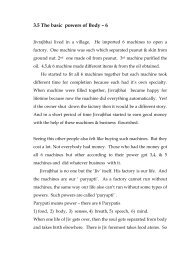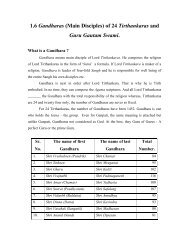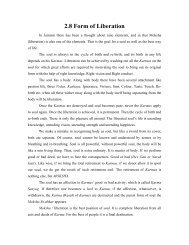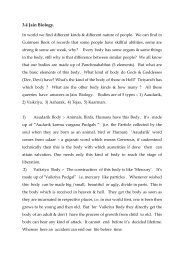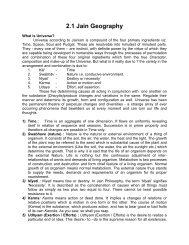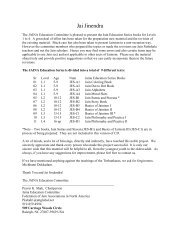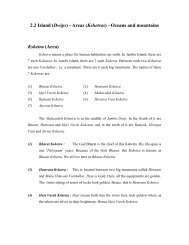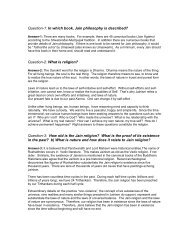Paryushan Parva - Jainism, Jain Religion - colleges
Paryushan Parva - Jainism, Jain Religion - colleges
Paryushan Parva - Jainism, Jain Religion - colleges
You also want an ePaper? Increase the reach of your titles
YUMPU automatically turns print PDFs into web optimized ePapers that Google loves.
Pratikraman in English with Meaning<br />
Going Back to the Path of Purification<br />
my faults. I do not have any animosity towards anybody, and I have friendship for all living beings.<br />
The process of shedding our karmäs really begins by asking for forgiveness with true feelings, and<br />
to take some vows not to repeat mistakes. The quality of the forgiveness requires humility (vinay -<br />
absence of ego) and suppression of anger.<br />
Svetämbars 7 (one of the major two <strong>Jain</strong> sects) celebrate eight days of <strong>Paryushan</strong> and the last day is<br />
called Samvatsari. Digambars 8 celebrate Dash-Lakshanä <strong>Parva</strong> for ten days starting on the last day<br />
of Shvetämbar <strong>Paryushan</strong>. They celebrate ten best characteristics of the soul: Kshamä<br />
(forgiveness), Märdav (Humility), Ärjav (straightforwardness), Shauch (content - absence of<br />
greed), Satya (truth), Samyam (restraint of all senses), Tapa (austerities), Tyäga (charity), Äkinchan<br />
(non-possessiveness) and Brahmachärya (celibacy).<br />
Six Essential Rituals (Ävashyaka)<br />
Contemplation of the soul is the main part of <strong>Jain</strong>inism 9 . Contemplation of the soul includes<br />
thinking, analyzing and meditating in addition to practicing the right conduct. Tirthankars have<br />
expounded many ways to free our selves of passions (anger, ego, deceit and greed) and, as a result,<br />
attain Moksha. One of the ways is expounded in six Ävashyaka. Practicing six essential rites with<br />
true feeling, one begins to free him/her-self of passions and helps progress spiritually. These six<br />
essential rites are to be practiced daily.<br />
1. Sämäyik – Equanimity, to remain calm and undisturbed, to discard all sinful activities and to<br />
engage in spiritual activities to be free of all passions, not to have feeling of liking or disliking, no<br />
attachment, no desire, no aversion. Sämäyik is the process that enhances the quality of equanimity.<br />
The process that takes one closer to the soul is Sämäyik. In brief, Sämäyik is the state of equanimity.<br />
From the realistic point of view, Sämäyik is the state of purified soul. It implies evenness of mind<br />
and temper.<br />
Spiritually, time spent in equanimity is the only successful time, and all other times are wasted. No<br />
one has attained Moksha, no one is attaining Moksha, and no one will attain Moksha without the<br />
practice of Sämäyik. To treat all living beings equal is the Sämäyik. To abandon the spiritually<br />
wrongful activities, and practice the spiritually right activities is Sämäyik. Sämäyik is the true<br />
conduct. Sämäyik is the essence of Tirthankar’s 10 teachings. Soul is Sämäyik. One has to practice<br />
Sämäyik to attain right perception, right knowledge and right conduct. <strong>Jain</strong> monks and nuns are<br />
supposed to be in the state of equanimity (Sämäyik) through out their life. Good Shrävaks 11 practice<br />
7 Svetämbar means white [cotton]-clad; name of <strong>Jain</strong> sect whose mendicants wear white garments<br />
8 Digambar means sky-clad; name of the <strong>Jain</strong> sect whose mendicants practice ascetic nudity<br />
9 <strong>Jain</strong> word is derived from Jina, which literally means "the Victor" or “the Liberator”. One who has freed<br />
himself/herself from the bondage of Karma by conquering räga (attachment - deceit and greed) & dvesha (aversion -<br />
anger and ego). People who follow the teachings of Jina are called <strong>Jain</strong>s. <strong>Jain</strong>s are also called shramanas (who treat<br />
everything with equanimity) or nirganthas (who does not have desires and passions). The teachings of Jina is called<br />
<strong><strong>Jain</strong>ism</strong>. Lord Mahavira was the last reformer of <strong><strong>Jain</strong>ism</strong>.<br />
10 The word tirth means ford (passage) and, therefore, tirthankar means builders of ford which leads us across the ocean<br />
of suffering. In this half time cycle we had 24 tirthankars, first one was Rushabhdev and the last one was Mahävir<br />
Swämi. Tirthankar has revealed the truth of the universe to us.<br />
11 Shrävaka is the person who is living in a house and practices the partial vows (anuvrata). The shrävaka word is<br />
derived from the word “shru” meaning to listen. Shrävaka listens to the preaching of the tirthankar or the right guru or<br />
reads the <strong>Jain</strong> canonical books. Shrävaka has faith in the path of liberation expounded by the tirthankars, who avoids<br />
6




